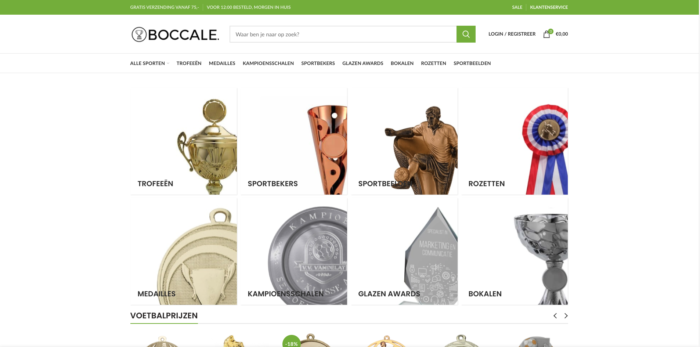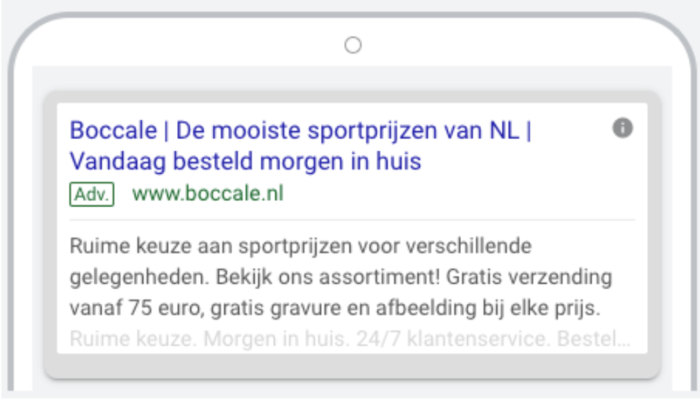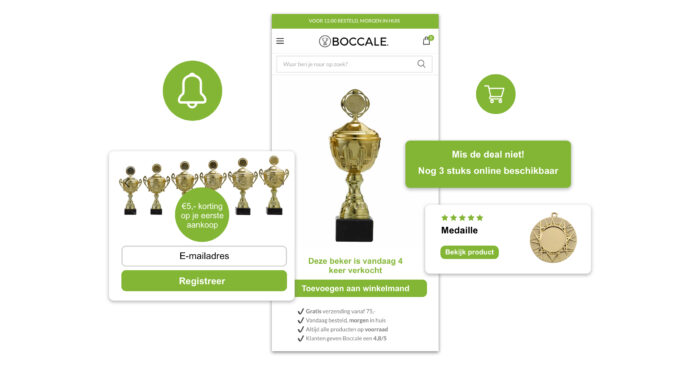How to get visitors to buy from you, and not from Bol.com, Amazon or AliExpress
We all still have them somewhere in the attic. A collection of medals from the evening four-day walk, a cup with the big ears from former sports competitions or a nice cup from local village games. These kinds of trophies are purchased by associations or individuals with regularity, therefore there is no shortage of vendors. This creates more and more tightness in the market where margins come under pressure. As a supplier, how do you ensure that you stay one step ahead of the competition? And how can we invest in more marketing where every euro is used effectively and where there are more euros in return? This challenge was presented to us by Koen Zwaan, owner of Boccale.
“This year we want to go full steam ahead. How are we going to do that?”
To fully understand the situation, we sat down together to first understand the market and users’ buying behavior. It quickly became apparent that the market is starting to get crowded must increasing sellers through, for example, Bol, Amazon or Alibaba with prices dropping. Distinctiveness lies mainly in good customer service, being well priced, and ultimately convincing people as strongly as possible to make their purchase from you. But well, how do you do that?
It was also important to understand Boccale’s processes. Here the challenge lay mainly in the fact that the product range is large, margins are very different per product and there was no clear strategy to market all these individual products in the right way.

This information guided the determination of the right strategy. The primary goal was simple: more sales. To make that more concrete, the following associated objectives were determined:
- Bringing more users to the website that are as likely as possible to actually place an order
- Once visitors are on the website make sure they buy products faster through a higher conversion rate
Starting with more interested visitors.
It quickly became clear the strategy to follow in this case. To get quick results, which was necessary, ads in Google, through social media and through display were set up. Finally, email marketing was also built.
For all this, the See, Think, Do, Care model was deployed, approaching users differently at each stage. Namely, through different channels and with different messages. For example, the emphasis in the See phase was on ads in Google, through both Search and Shopping. This is where people start their search and where we can make sure we reach only relevant people. In the Think phase, that included ads through Facebook and Instagram, for example. Visitors had viewed certain products on the website, probably also visited competitors, but now they had to be persuaded. And quickly too, because the purchase time is quite short. In the Do phase, when we were convinced that people were about to buy from us or a competitor, we pulled out all the stops to bring that person in by using Display ads. Finally, in the Care phase, we built an e-mail sequence to keep people engaged. In order to eventually convince them to leave a good review, which in turn could convince potential new customers. Almost all important channels were deployed, and to do this efficiently it is important that these channels are combined and work together.

In addition, the product feed was optimized, with each product showing up, for example, with the right ad text and with the right price. This also meant that when products were out of stock, for example, they were no longer promoted. Or that people who had already bought something were no longer bothered with ads, because they almost never place a second order in the short term and therefore would not yield a positive ROI. But also that when there was a sale, this new price was immediately shown in the ads.
Visitors need to be convinced
New relevant visitors are now being brought in. But how do we make sure we overwhelm them even more, do everything possible to convince them even more to actually place a bets order?
Through data analysis and using Cialdini’s principles of persuasion! Through data analysis we understood how likely someone was to make a purchase, how far along in the customer journey they were. We could determine this, for example, by looking at which keywords they had clicked on (general or very specific ones?), which pages and/or products they viewed or how long they stayed on the website. Depending on where that person was in their journey, they were approached more often with specific ads via different channels.
In order to keep users on the website as much as possible and make them buy, Cialdini’s principles of persuasion were used as A/B tests. Specifically, we showed, for example, how many products were still in stock (creates a sense of scarcity), how many people were currently shopping (creates a sense of urgency) or by showing clear reviews (provides social proof). This also involved using data analysis to see which persuasion principles the user was most likely to be sensitive to in order to show the right information.

